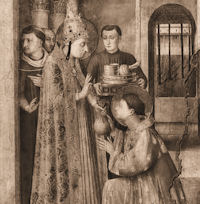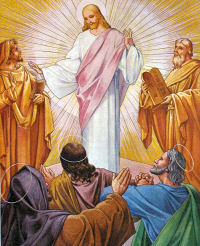Ordinary Time: August 6th
Feast of the Transfiguration
» Enjoy our Liturgical Seasons series of e-books!
Old Calendar: Transfiguration of Our Lord; St. Sixtus II, pope & Felicissimus & Agapitus, martyrs
This feast became widespread in the West in the 11th century and was introduced into the Roman calendar in 1457 to commemorate the victory over Islam in Belgrade. Before that, the Transfiguration of the Lord was celebrated in the Syrian, Byzantine, and Coptic rites. The Transfiguration foretells the glory of the Lord as God, and His Ascension into heaven. It anticipates the glory of heaven, where we shall see God face to face. Through grace, we already share in the divine promise of eternal life.
According to the 1962 Missal of St. John XXIII the Extraordinary Form of the Roman Rite, in addition to the Feast of the Transfiguration; today is also the feast Sts. Sixtus II and Felicissimus & Agapitus who were martyred during the persecution of Valerian.
The Transfiguration
Our divine Redeemer, being in Galilee about a year before His sacred Passion, took with him St. Peter and the two sons of Zebedee, Sts. James and John, and led them to a retired mountain. Tradition assures us that this was Mount Thabor, which is exceedingly high and beautiful, and was anciently covered with green trees and shrubs, and was very fruitful. It rises something like a sugar-loaf, in a vast plain in the middle of Galilee. This was the place in which the Man-God appeared in His glory.
Whilst Jesus prayed, he suffered that glory which was always due to his sacred humility, and of which, for our sake, He deprived it, to diffuse a ray over His whole body. His face was altered and shone as the sun, and his garments became white as snow. Moses and Elias were seen by the three apostles in his company on this occasion, and were heard discoursing with him of the death which he was to suffer in Jerusalem.
The three apostles were wonderfully delighted with this glorious vision, and St. Peter cried out to Christ, "Lord, it is good for us to be here. Let us make three tents: one for thee, one for Moses, and one for Elias" Whilst St. Peter was speaking, there came, on a sudden, a bright shining cloud from heaven, an emblem of the presence of God's majesty, and from out of this cloud was heard a voice which said, "This is my beloved Son, in whom I am well pleased; hear ye him" The apostles that were present, upon hearing this voice, were seized with a sudden fear, and fell upon the ground; but Jesus, going to them, touched them, and bade them to rise. They immediately did so, and saw no one but Jesus standing in his ordinary state.
This vision happened in the night. As they went down the mountain early the next morning, Jesus bade them not to tell any one what they had seen till he should be risen from the dead.
Excerpted from Butler's Lives of the Saints, Benziger Bros. ed. [1894]
In the Transfiguration Christ enjoyed for a short while that glorified state which was to be permanently His after His Resurrection on Easter Sunday. The splendor of His inward Divinity and of the Beatific Vision of His soul overflowed on His body, and permeated His garments so that Christ stood before Peter, James, and John in a snow-white brightness. The purpose of the Transfiguration was to encourage and strengthen the Apostles who were depressed by their Master's prediction of His own Passion and Death. The Apostles were made to understand that His redeeming work has two phases: The Cross, and glory—that we shall be glorified with Him only if we first suffer with Him.
— Rt. Rev. Msgr. Rudolph G. Bandas
Sts. Sixtus II & Felicissimus & Agapitus The Martyrs Archdeacon Laurence, Pope Sixtus, Deacons Felicissimus and Agapitus, the Soldier Romanus were citizens of Rome, and suffered in the year 258 under the emperor Valerian (253-259). Holy Pope Sixtus, born at Athens, received a fine education, preached in Spain and was made bishop in Rome following the martyr's death of Holy Pope Stephen. These were times when a pope occupying the Roman throne, was known to choose death for the faith. In a short while St Sixtus also was arrested and put in prison together with his deacons Felicissimus and Agapitus.
The Martyrs Archdeacon Laurence, Pope Sixtus, Deacons Felicissimus and Agapitus, the Soldier Romanus were citizens of Rome, and suffered in the year 258 under the emperor Valerian (253-259). Holy Pope Sixtus, born at Athens, received a fine education, preached in Spain and was made bishop in Rome following the martyr's death of Holy Pope Stephen. These were times when a pope occupying the Roman throne, was known to choose death for the faith. In a short while St Sixtus also was arrested and put in prison together with his deacons Felicissimus and Agapitus.
When the holy archdeacon Laurence visited Pope Sixtus, whom they held in prison, he cried out with tears: "Whither art thou gone, father? Why hast thou forsaken thine archdeacon, with whom always thou hast offered the Bloodless Sacrifice? Take thy son with thee, that I may be thy companion in having blood shed for Christ!" St Sixtus answered him: "I have not forsaken thee, my son. I am old and go to an easy death, but yet greater sufferings await thee. Know, that after three days upon our death thou shalt follow after me. And now go, take the church treasury and distribute it to the poor and needy Christians." St Laurence zealously did the bidding of the holy hierarch.
Having heard, that Pope Sixtus had been taken to trial with the deacons, St Laurence went there so as to witness their deed, and he said to the holy bishop: "Father, I have already fulfilled thy command, and distributed by hand thine treasury; forsake me not!" Hearing something about treasure, soldiers put him under guard, and the other martyrs were beheaded (+6 August 258).
